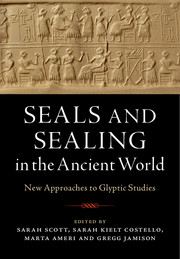 Seals and Sealing in the Ancient World
Seals and Sealing in the Ancient World Book contents
- Seals and Sealing in the Ancient World
- Seals and Sealing in the Ancient World
- Copyright page
- Contents
- Notes on Contributors
- Illustrations
- Plates
- Tables
- Acknowledgments
- Preface
- Abbreviations
- Chapter One Introduction: Small Windows, Wide Views
- Part I The Ancient Near East and Cyprus
- Chapter Two Administrative Role of Seal Imagery in the Early Bronze Age: Mesopotamian and Iranian Traders on the Plateau
- Chapter Three Slave Labor: Uruk Cylinder-Seal Imagery and Early Writing
- Chapter Four The First Female Bureaucrats: Gender and Glyptic in Third-Millennium Northern Mesopotamia
- Chapter Five Rematerializing the Early Dynastic Banquet Seal
- Chapter Six Sealing Practices in the Akkadian Period
- Chapter Seven Authenticity, Seal Recarving, and Authority in the Ancient Near East and Eastern Mediterranean
- Part II South Asia and the Gulf Region
- Part III Egypt
- Part IV Aegean
- References
- Endnotes
- Index
Chapter Seven - Authenticity, Seal Recarving, and Authority in the Ancient Near East and Eastern Mediterranean
from Part I - The Ancient Near East and Cyprus
Published online by Cambridge University Press: 24 April 2018
- Seals and Sealing in the Ancient World
- Seals and Sealing in the Ancient World
- Copyright page
- Contents
- Notes on Contributors
- Illustrations
- Plates
- Tables
- Acknowledgments
- Preface
- Abbreviations
- Chapter One Introduction: Small Windows, Wide Views
- Part I The Ancient Near East and Cyprus
- Chapter Two Administrative Role of Seal Imagery in the Early Bronze Age: Mesopotamian and Iranian Traders on the Plateau
- Chapter Three Slave Labor: Uruk Cylinder-Seal Imagery and Early Writing
- Chapter Four The First Female Bureaucrats: Gender and Glyptic in Third-Millennium Northern Mesopotamia
- Chapter Five Rematerializing the Early Dynastic Banquet Seal
- Chapter Six Sealing Practices in the Akkadian Period
- Chapter Seven Authenticity, Seal Recarving, and Authority in the Ancient Near East and Eastern Mediterranean
- Part II South Asia and the Gulf Region
- Part III Egypt
- Part IV Aegean
- References
- Endnotes
- Index
Summary
Recarving is a common feature of many Bronze and Iron Age Near Eastern and eastern Mediterranean cylinder-seal designs. Stamp seals were rarely recarved. Abrasion and recutting resulted in changes that pose core questions about the nature of seal authenticity and authority. Recarving altered the authoritative relationship between the image on a seal and its impression in clay or wax, yet it also lent cylinder seals a greater weight of authenticity. This study considers vocabularies, texts documenting seal redesign, and examples of seal recarving from the third to the first millennia BCE from Iran to the Aegean. It illustrates several examples from the island of Cyprus that inspired this broader inquiry. The authority invested in cylinder seals could draw on generations of power and seal designs from far distant places. The limits of that authority varied geographically and chronologically as well as by economic, social, and political context. Recarved inscriptions were most typical of cylinder seals in contexts of centralized bureaucracy and royal power in the Near East. By contrast, cylinder seals with recarved figural designs were more characteristic of people involved in long-distance exchange. Detailed contextualized studies of recarving expand our knowledge of how seals were used to express the maintenance, transfer, and transformation of power within and among cultures with varying degrees of bureaucratic complexity.
- Type
- Chapter
- Information
- Seals and Sealing in the Ancient WorldCase Studies from the Near East, Egypt, the Aegean, and South Asia, pp. 95 - 124Publisher: Cambridge University PressPrint publication year: 2018
- 2
- Cited by
